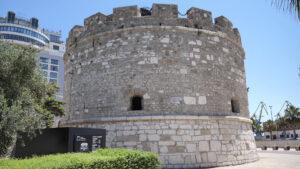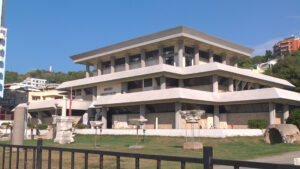Located on the ancient ruins of Epidamnus, Durrës was founded approximately in 627 B.C.
Archaeological and historical sites of the city that must be visited:

The surrounding walls of the city are concrete evidence of the importance of ancient Dyrrah in ancient times.
These walls were constructed around the 5th century AD by Emperor Anastasi I of Durrës, and they are widely accessible to anyone.
The surrounding walls are a part of the Byzantine fortification and provide a sense of admiration for a portion of the city’s centuries-old heritage for both foreign and local visitors.
Similar to 1273, the surrounding walls did not escape the damage caused by the devastating earthquake of November 26, 2019, in Durrës. Tower C was demolished and rebuilt for the second time, and the blocks and materials were removed.

Venetian tower
The white battlemented tower, constructed in the fifteenth century and located very near the surrounding walls, represents the city.
After the restoration, completed in 2023, the “Monument of Culture,” category I, has become the center for interpreting the city’s cultural heritage through 3D technology.

The entrance is accessible on the last Sunday of every month.
The round tower is built over a tower from the Byzantine period. It has a diameter of 16 meters and a height of 9 meters and is equipped with five turrets and three compartments.
The ascent is made from the inside, with narrow, steep stone stairs.
Along with the building of the Commercial Bank, the Venetian Tower is ubiquitous on souvenirs and postcards with the theme of Durres.

Amphitheater
The amphitheater is the most magnificent monument of Durrës. This monument was built in the 2nd century AD, proving the importance of the city near the Adriatic Sea during the period of the Roman Empire.
Even though it has not been thoroughly explored, the amphitheater offers visitors a journey into antiquity because the master builders’ original design is still present.
The ellipse-shaped building, partially resting on the hill, held up to 20,000 spectators who watched gladiator matches in its arena.
Inside the amphitheater, there is also a small church and a mural mosaic.

The entrance is accessible on the last Sunday of every month.
After the 5th century, when gladiator matches were banned, the Amphitheater became a cemetery, and several chapels with frescoes and mosaics were built under its steps.
The amphitheater was discovered between 1966 and 1970. Archaeological expeditions are conducted almost annually, and sometimes, they reveal the treasures that the underground of Durrës still conceals.
Once a project led by the Albanian-American Foundation for Development makes the amphitheater’s full discovery possible, this exceptional monument of Albanian cultural heritage will become a destination not only in the region but also globally.

Byzantine Forum
The market square of the Byzantine period is believed to have been built in the 6th century AD and occupied a central position among the large public and religious buildings of ancient Dyrrah.
Its architecture testifies to the function of a round market square with a portico.
The construction technique and materials used make this monument contemporary, based on the public constructions carried out during the reigns of emperors Anastasi I and Justinian.
Its visitation is included in all local tour guides.

Roman baths
The ancient Roman baths are located in the center of the city and can only be admired from the outside, as they are not open to the public.
They were discovered by chance in 1960, and the city’s Cultural Center was built on them, but the ancient monument still needed to be protected.
The baths strictly preserve the Roman style of the time when they were constructed.
The ruins of the former baths include the apodyterium (dressing room) and the tepidarium (sauna), which has hypocaust bricks under the floor for the passage of hot steam.
The frigidarium (cold bath) is in the southern direction, and the swimming pool is at the end. The flooring is made of black and white marble tiles shaped like a chessboard.

Castle of Ishmi and Shna Ndou Church
The Castle of Ishmi, built in the 16th century, is a destination to be noticed.
The Shna Ndou church, with its Romanesque-Gothic architecture from the 13th century, is one of the most critical assets of Ishmi’s cultural heritage.
Shna Ndou Church is also a place of pilgrimage for the residents of the area and not only because of its importance as a cult object of the Christian religion.
The church returned to believers and tourists thanks to the investment made through the EU4Culture program, which enabled the restoration of this monument damaged by the earthquake of 2019.

Archaeological Museum
It is the most important national museum exhibiting artifacts from the archaic period, the Illyrian civilization, to the late Middle Ages.
It is currently undergoing restoration but will be open soon.
The restoration made possible by the EU4Culture program, funded by the European Union, aims to attract more local and foreign tourists to this museum.
The Archaeological Museum (in its current location) was inaugurated on April 13, 2002, while the first archaeological museum was opened on March 13, 1951.
Over the years, its location has changed several times.
The earthquake of November 26, 2019, caused extensive damage to the building. Three years later, the three-story building underwent restoration thanks to an investment in the EU4Culture program, which is funded by the European Union.

Ethnographic Museum
The 2-storey building with a terrace (chardak), located in the heart of the city’s historical area, offers visitors a panorama of the architectural development of Durrës in the 19th century.
Currently closed, it is expected to undergo restoration.
In the 30s of the century XX, the building was the headquarters of the English consulate. Durrës is also known as the home of Aleksandër Moisiu (1879-1935), the world-famous actor who spent several years of childhood in the coastal city.
The museum consisted of five rooms, two of which displayed documents, testimonies, and photographs belonging to the actor Moisiu. In the other three rooms, traditional folk clothes and handicraft products of the region of Durrës and its surroundings were displayed.
The earthquake severely damaged the building five years ago, and it has been closed ever since.





